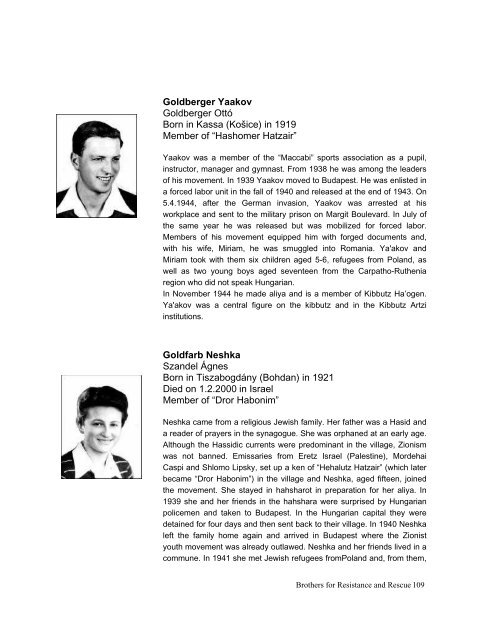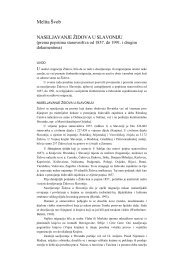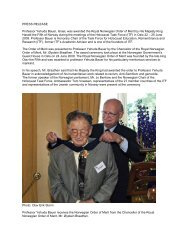Brothers for Resistance and Rescue 1 - CENDO
Brothers for Resistance and Rescue 1 - CENDO
Brothers for Resistance and Rescue 1 - CENDO
Create successful ePaper yourself
Turn your PDF publications into a flip-book with our unique Google optimized e-Paper software.
Goldberger Yaakov<br />
Goldberger Ottó<br />
Born in Kassa (Košice) in 1919<br />
Member of “Hashomer Hatzair”<br />
Yaakov was a member of the “Maccabi” sports association as a pupil,<br />
instructor, manager <strong>and</strong> gymnast. From 1938 he was among the leaders<br />
of his movement. In 1939 Yaakov moved to Budapest. He was enlisted in<br />
a <strong>for</strong>ced labor unit in the fall of 1940 <strong>and</strong> released at the end of 1943. On<br />
5.4.1944, after the German invasion, Yaakov was arrested at his<br />
workplace <strong>and</strong> sent to the military prison on Margit Boulevard. In July of<br />
the same year he was released but was mobilized <strong>for</strong> <strong>for</strong>ced labor.<br />
Members of his movement equipped him with <strong>for</strong>ged documents <strong>and</strong>,<br />
with his wife, Miriam, he was smuggled into Romania. Ya'akov <strong>and</strong><br />
Miriam took with them six children aged 5-6, refugees from Pol<strong>and</strong>, as<br />
well as two young boys aged seventeen from the Carpatho-Ruthenia<br />
region who did not speak Hungarian.<br />
In November 1944 he made aliya <strong>and</strong> is a member of Kibbutz Ha’ogen.<br />
Ya'akov was a central figure on the kibbutz <strong>and</strong> in the Kibbutz Artzi<br />
institutions.<br />
Goldfarb Neshka<br />
Sz<strong>and</strong>el Ágnes<br />
Born in Tiszabogdány (Bohdan) in 1921<br />
Died on 1.2.2000 in Israel<br />
Member of “Dror Habonim”<br />
Neshka came from a religious Jewish family. Her father was a Hasid <strong>and</strong><br />
a reader of prayers in the synagogue. She was orphaned at an early age.<br />
Although the Hassidic currents were predominant in the village, Zionism<br />
was not banned. Emissaries from Eretz Israel (Palestine), Mordehai<br />
Caspi <strong>and</strong> Shlomo Lipsky, set up a ken of “Hehalutz Hatzair” (which later<br />
became “Dror Habonim”) in the village <strong>and</strong> Neshka, aged fifteen, joined<br />
the movement. She stayed in hahsharot in preparation <strong>for</strong> her aliya. In<br />
1939 she <strong>and</strong> her friends in the hahshara were surprised by Hungarian<br />
policemen <strong>and</strong> taken to Budapest. In the Hungarian capital they were<br />
detained <strong>for</strong> four days <strong>and</strong> then sent back to their village. In 1940 Neshka<br />
left the family home again <strong>and</strong> arrived in Budapest where the Zionist<br />
youth movement was already outlawed. Neshka <strong>and</strong> her friends lived in a<br />
commune. In 1941 she met Jewish refugees fromPol<strong>and</strong> <strong>and</strong>, from them,<br />
<strong>Brothers</strong> <strong>for</strong> <strong>Resistance</strong> <strong>and</strong> <strong>Rescue</strong> 109




